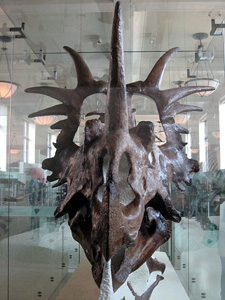New
York Museum of Natural History
The American Museum of Natural History (AMNH) can be
found on the Upper West Side of Manhattan as one of the biggest and
most celebrated museums in the world, with park like grounds, just
across the street from Central Park, and is made of 25
interconnected structures that contain 46 permanent exhibition
halls, world famous library and research labs. The collection houses
more than 32 million specimens that allow just a fraction of the
entire collection to be shown at any given time, with a scientific
staff of over 200 and sponsors more than 100 special field
expeditions every year. It was founded in 1869, and before getting
its current complex would be houses in the older Arsenal building in
Central Park. Theodore Roosevelt, Sr., the father of the 26th
President, was one of the original founders, as well as other famous
and influential men in the city that included J. Pierpont Morgan,
Morris K. Jesup, Moses H. Grinnell, A. G. Phelps Dodge, Joseph H.
Choate, Charles A. Dana and Henry G. Stebbins. In 1874, the
cornerstone was laid, for the museum's first structure, that has now
been hidden from view by the numerous other structures that have
been built and occupy the majority of Manhattan Square. That
original Victorian gothic style building, that opened in 1877, had
been designed by Calvert Vaux and J. Wrey Mould, but soon eclipsed
by the structure designed by J. Cleaveland Cady that produced a
rusticated brownstone neo-renaissance, that had been influenced by
H. H. Richardson. The entrance on Central Park West was designed by
John Russell Pope in 1936 and is considered an over scale beaux arts
monument that leads to a Roman basilica, where visitors are welcomed
by a cast of a skeleton of a rearing Barosaurus that is defending
her young from an Allosaurus. Not much has changed since 1930,
except for the collections continuing to grow and expand, installing
enormous and incredible habitat dioramas of North American, Asian
and African mammals, a huge 31 ton piece of the Cape York meteorite,
the Star of India which is the biggest star sapphire ever discovered
in the world, a full size model of a blue whale that is suspended in
the Milstein Family Hall of Ocean Life, a 62 foot Haida carved and
painted war canoe from the Pacific northwest and the rest of the
floor that is dedicated to vertebrate evolution.
|

